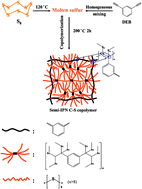Sulfur-rich polymeric materials with semi-interpenetrating network structure as a novel lithium–sulfur cathode
Abstract
Novel polymeric materials with a very high content of sulfur were successfully synthesized via a facile copolymerization of elemental sulfur with 1,3-diethynylbenzene (DEB). For the as-prepared sulfur-rich polymeric materials (C–S copolymer), diynes or polydiynes are chemically cross-linked with a large amount of polymeric sulfur to form a cage-like semi-interpenetrating network (semi-IPN) structure. Due to the strong chemical interaction of sulfur with the carbon framework and the unique cage-like structure in C–S copolymers, the dissolution and diffusion of polysulfides out of the cathode is effectively suppressed through chemical and physical means. As a result, the sulfur-rich C–S polymeric materials with semi-IPN structure exhibit excellent cycling stability and high coulombic efficiency. The initial discharge capacity is 1143 mA h g−1 at a 0.1 C rate. The capacity still remains at 70% even after about 500 cycles at a high current density of 1 C. In addition, a high coulombic efficiency of over 99% is obtained during the entire range of cycling.


 Please wait while we load your content...
Please wait while we load your content...